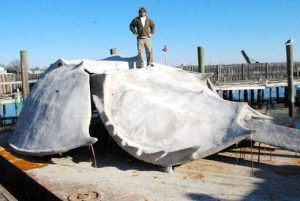North Carolina Fisheries Association
 Last Tuesday evening (October 4,2022) I attended a striped mullet scoping meeting where staff from the NC Division of Marine Fisheries (DMF) were seeking stakeholder input for the future management of the mullet fishery. DMF staff certainly got an ear full of “input”, mostly in the form of questions and comments about the most recent Striped Mullet Stock assessment. The 2022 Striped Mullet assessment (Click Here to Open), which used data through 2019 indicated that overfishing is occurring, and that North Carolinas Striped Mullet stock is overfished, and apparently has been for two decades or more. This came as a shock for the fishermen in attendance for a couple of reasons.
Last Tuesday evening (October 4,2022) I attended a striped mullet scoping meeting where staff from the NC Division of Marine Fisheries (DMF) were seeking stakeholder input for the future management of the mullet fishery. DMF staff certainly got an ear full of “input”, mostly in the form of questions and comments about the most recent Striped Mullet Stock assessment. The 2022 Striped Mullet assessment (Click Here to Open), which used data through 2019 indicated that overfishing is occurring, and that North Carolinas Striped Mullet stock is overfished, and apparently has been for two decades or more. This came as a shock for the fishermen in attendance for a couple of reasons.
First, for the last two to three years, which were not included in the assessment, fishermen have been seeing increasing numbers of mullet in our state waters leading many to believe the stock is expanding. Second, and even more concerning, is the fact that the last assessment, completed in 2018, which used data from 1994 to 2017 indicated that overfishing was not occurring, and the stock was not overfished, nor had it ever been.
That’s right, in just four years the stock went from never having been “overfished” to now having been “overfished” for decades! As you might imagine, this has left many fishermen frustrated and questioning how this is even possible.
Afterall, we only have two years of new data since the last assessment. How can two years of commercial harvest data and DMF sampling change the stock status for two decades? The short answer is that two additional years of data and the stock status aren’t the only things that have changed.
The first Striped Mullet stock assessment was completed in the early 2000’s, during the development of the Striped Mullet Fishery Management Plan (FMP), using data from 1994-2002 and concluded that overfishing was not occurring. In 2013, the “Benchmark Assessment” was completed using the same assessment model as the previous assessment and updated data from 1994-2011 and, once again, it was determined that overfishing was not occurring.
Now, common sense would suggest that once a stock assessment was completed, peer reviewed, and accepted for management that the same sources of data, overfishing thresholds/targets, and assessment models would be used for future reviews, with the only new information being the most recent years of data. Unfortunately, common sense evidently has no place in the world of fisheries management.
Since the 2013 benchmark assessment, one Amendment and two assessments have been completed, resulting in new overfishing targets/thresholds, the exclusion of multiple sources of data, an extended time series (1950-2019) and a dramatic change in stock status. It may be hard for you to believe that these seemingly insignificant changes can have such a dramatic impact on abundance estimates, but it can, and this isn’t the first time it’s happened!
In 2009, DMF completed the Spotted Sea trout (Speckled Trout) stock assessment which indicated that the fishery had been overfished with overfishing occurring for the entire time series (1991-2006), 18 years.
An update of that assessment which included data from 2007 and 2008 resulted in the same conclusion, overfished and overfishing for 20 years, at least, possibly longer if they had included data prior to 1991. The results of this stock assessment, which was peer reviewed and accepted for management, led to the adoption of strict harvest reductions (40%) for both commercial and recreational sectors, through the FMP in 2012.
Three short years later, in 2015, another assessment was completed. This new assessment utilized a different computer model, changed the fishing year from a calendar year to a biological year (March 1- February 28), decreased the maximum age of Speckled Trout from 12 to 9, and added new tagging data, which according to DMF did not have a significant influence on results.
Once again, a few, seemingly minor, changes to the assessment produced radically different results. The Speckled Trout stock, which had previously been overfished for at least two decades was now not overfished or experiencing overfishing and never had been, not even for the two decades from 1991-2008!
You’re probably thinking at least this drastic change was a positive one. Afterall, if the stock isn’t overfished there’s no further need for the 40% harvest reduction.
Right? Wrong!
Ten years later and the strict harvest reductions meant to rebuild a stock which had been overfished for two decades are still in place despite the new determination that the stock has never been overfished!
It’s no wonder that the fishermen who attended the mullet scoping meeting were so frustrated, they’re damned if they do and damned if they don’t. With such drastic changes from one assessment to another, how can anyone commercial, recreational, consumer, or scientist have any faith in these results?
Would a couple of minor changes to the Southern Flounder assessment have saved us from these draconian 72% harvest reductions?
From what I’ve seen I’d say absolutely!
The question is, which assessment is right? If any!
Should we have used data from 1994-2019 or 1950-2019? Should the overfishing threshold be raised or lowered?
How long do Speckled Trout live? (I found ranges from 8 years to 18 years) Do mature Southern Flounder return to NC estuaries after spawning or remain offshore?
Unfortunately, I don’t have the answers to these questions and, to be frank, it doesn’t appear that anyone else does either. What I do know is that the decisions DMF staff make have a dramatic impact on these assessments and the citizens of this State. I also know that our states statutes and outside pressures often force them to take action even when uncertainty is extremely high.
That said, we deserve better and should demand better and I firmly believe the State can do better for all stakeholders not just a fortunate few.
Glenn Skinner
NCFA-Executive Director















































